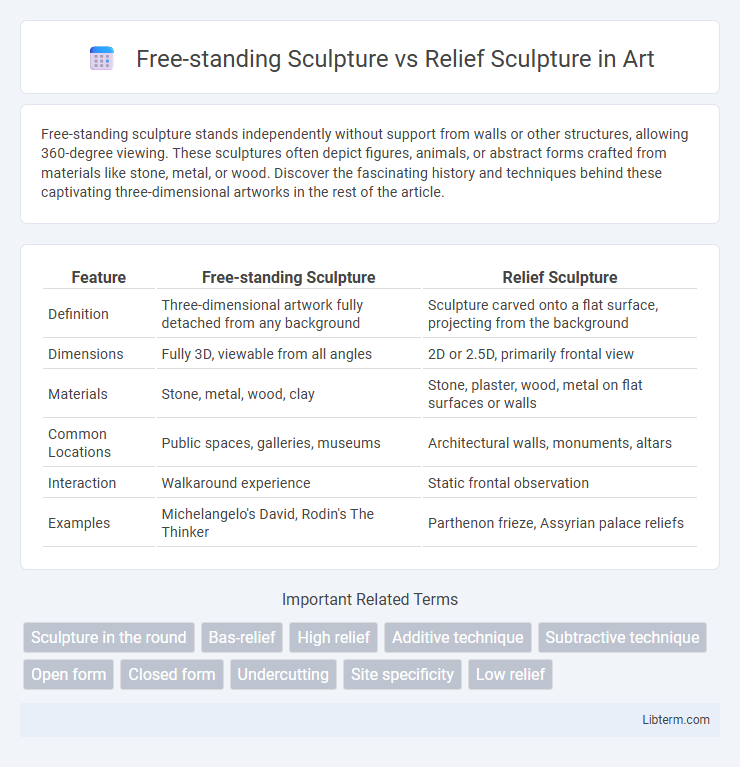Free-standing sculpture stands independently without support from walls or other structures, allowing 360-degree viewing. These sculptures often depict figures, animals, or abstract forms crafted from materials like stone, metal, or wood. Discover the fascinating history and techniques behind these captivating three-dimensional artworks in the rest of the article.
Table of Comparison
| Feature | Free-standing Sculpture | Relief Sculpture |
|---|---|---|
| Definition | Three-dimensional artwork fully detached from any background | Sculpture carved onto a flat surface, projecting from the background |
| Dimensions | Fully 3D, viewable from all angles | 2D or 2.5D, primarily frontal view |
| Materials | Stone, metal, wood, clay | Stone, plaster, wood, metal on flat surfaces or walls |
| Common Locations | Public spaces, galleries, museums | Architectural walls, monuments, altars |
| Interaction | Walkaround experience | Static frontal observation |
| Examples | Michelangelo's David, Rodin's The Thinker | Parthenon frieze, Assyrian palace reliefs |
Introduction to Sculpture: Free-standing vs Relief
Free-standing sculptures are three-dimensional artworks that can be viewed from all sides, existing independently in space without any support or background. Relief sculptures, on the other hand, are carved or modeled on a flat surface, with the figures projecting partially from the background, creating a blend of two-dimensional and three-dimensional elements. Both forms represent fundamental approaches in sculpture, offering diverse ways to express depth, texture, and narrative in art.
Defining Free-standing Sculpture
Free-standing sculpture is a three-dimensional artwork designed to be viewed from all angles, standing independently without any attached background or support. This type of sculpture occupies space freely and allows for full spatial interaction, contrasting with relief sculpture which is carved into or projects from a flat surface. Famous examples of free-standing sculptures include Michelangelo's David and Rodin's The Thinker.
Understanding Relief Sculpture
Relief sculpture is a form of sculptural art where the figures are raised above a flat background, creating a three-dimensional effect while remaining attached to the surface. Unlike free-standing sculptures, which are fully detached and viewable from all angles, relief sculptures are primarily designed for viewing from the front, emphasizing depth through varying degrees of projection such as high relief (alto-relievo) and low relief (bas-relief). Understanding relief sculpture involves recognizing its historical significance in architectural decoration, storytelling, and symbolic representation across cultures like Ancient Egypt, Mesopotamia, and the Renaissance.
Historical Evolution of Both Forms
Free-standing sculpture, emerging prominently in ancient Greece, evolved from rigid archaic forms to dynamic, naturalistic representations seen in Classical and Hellenistic periods, emphasizing three-dimensionality and spatial interaction. Relief sculpture, with roots in Mesopotamian and Egyptian art, developed through bas-relief and high relief styles to narrate historical and mythological scenes on walls and monuments, integrating with architectural surfaces. Both forms reflected cultural values and technological advances, shaping artistic expression from antiquity through Renaissance and modern art.
Key Differences in Structure and Technique
Free-standing sculptures are fully three-dimensional works designed to be viewed from all angles, featuring complete forms that occupy space independently without any background support. Relief sculptures are partially attached to a solid background, creating a raised design that projects only slightly from the surface, classified as low (bas-relief) or high relief based on the depth of projection. Structural differences influence techniques: free-standing requires modeling or carving in the round to achieve volumetric form, while relief involves carving or casting shallow planes integrated into a flat substrate.
Artistic Expression and Visual Impact
Free-standing sculptures offer a fully three-dimensional artistic expression, allowing viewers to experience the work from multiple angles and creating an immersive visual impact. Relief sculptures are characterized by their partial depth, often integrated into a background surface, which guides the viewer's focus on a specific narrative or theme. The dimensional limitations of relief sculpture enhance storytelling through controlled perspective and shadow play, while free-standing works emphasize form, volume, and spatial interaction.
Materials and Methods Used
Free-standing sculptures primarily use materials such as marble, bronze, and wood, allowing artists to shape the work fully in three dimensions using techniques like carving, casting, and modeling. Relief sculptures, typically created on stone, plaster, or metal surfaces, involve methods like engraving, carving, or embossing to produce raised or sunken images that remain part of a background plane. The choice of material and method directly influences the artwork's depth, texture, and spatial interaction, distinguishing fully autonomous sculptures from those integrated into architectural or surface contexts.
Notable Examples in Art History
Michelangelo's David exemplifies free-standing sculpture, showcasing three-dimensional form meant to be viewed from all angles, while the Parthenon Marbles highlight relief sculpture, where figures project from a flat background integrated into architectural spaces. The Gates of Paradise by Lorenzo Ghiberti further illustrate relief sculpture's narrative depth through intricate, raised scenes. These notable examples underscore the distinct spatial interaction and storytelling methods intrinsic to free-standing and relief sculptures in art history.
Preservation and Display Considerations
Free-standing sculptures require ample space and stable pedestals to ensure proper preservation, as they are exposed to all sides and susceptible to environmental damage. Relief sculptures, often integrated into walls or architectural elements, benefit from the protection and support of their mounting surfaces, which can reduce physical stress and wear. Displaying free-standing works demands controlled environments with careful lighting to prevent deterioration, while reliefs typically require preservation strategies that address wall conditions and humidity control.
Choosing the Appropriate Form for Artistic Intent
Free-standing sculpture offers a fully three-dimensional form that allows viewers to engage with the artwork from all angles, making it ideal for conveying a dynamic presence or narrative. Relief sculpture, by being attached to a background surface, emphasizes depth through varying levels of projection and is effective for storytelling within a spatial context. Selecting between free-standing and relief sculpture depends on the desired interaction, spatial constraints, and the narrative or emotional impact the artist intends to achieve.
Free-standing Sculpture Infographic

 libterm.com
libterm.com